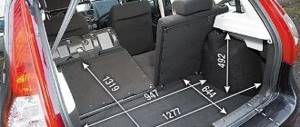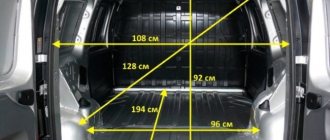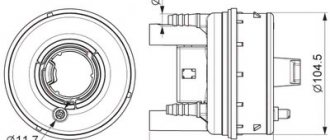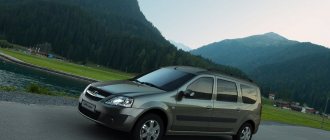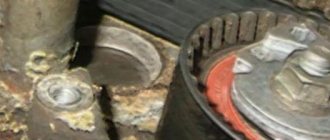Why is the volume of the Lada Largus fuel tank important?
You will probably say that the volume of the fuel tank is not so important for the average car owner. And this is actually true. Typically, car owners fill up at a gas station for a certain amount, for example, a thousand or one and a half. And they drive until the next gas station. However, when you are going on a long trip, the volume of the tank can play a decisive role - after all, there are not always gas stations along the way, and there may not be enough fuel.
Layout and transformation
The design of the Lada Largus cargo van is built on the principle of removing everything unnecessary from a basic passenger car with a station wagon body. All geometric parameters, such as length, width, roof height, base, track, remained the same. The design of the doors has not changed either, only the van doors have lost their glazing, and the roof has lost its roof rails. But the rear side doors have been preserved, and all four doors can be locked from the outside with a key.
There is no upholstery, with the exception of small trims on the doors. The van is dominated by bare painted iron, with a rudimentary rubber covering on the floor. But they didn’t forget about the loops for securing the load, and the protruding fastenings of the rear shock absorbers were covered with protective caps. These caps will be protected not by studs and nuts, whatever they will be, but, most likely, by the delicate elements of the cargo.
When describing cargo vans and utility vehicles, it is appropriate to remember the term “transformation of the luggage compartment or cargo compartment.” So there is absolutely nothing to transform here! They simply removed everything unnecessary from the base station wagon and installed a blank plastic partition behind the front seats. I don't entirely agree with this ideology. In my opinion, it would be better if we kept the glazing of at least one of the wings of the rear swing door of the van and equipped it with a windshield wiper; accordingly, there must be a window in the partition, and the floor and sides of the interior of the van must be protected a little more carefully. In the current version, the driver has no control over the “trunk” at all, plus there is no indication of open doors in the instrument cluster. Thank you, at least they provided a lampshade.
Fuel tank volume Lada Largus
The volume of the Lada Largus gas tank is a value in liters that shows how much fuel can be stored in an empty tank before it is fully refueled. If we delve a little deeper into the theory, we can compare that cars of different classes travel approximately the same distance on a full tank without refueling.
And here it doesn’t really matter what engine size the car has. There is another pattern - the larger the engine volume, the larger the fuel tank volume.
This pattern can be explained. If a 1.0-1.5 liter engine is installed under the hood, then such cars will have a 30-35 liter tank. If the engine is 1.5-2.5 liters - the tank is 40-60 liters, over 2.5 liters - 60 or more.
What is the volume of the fuel tank actually needed for? We have already found out that knowing the volume of the tank will allow you to fill the required amount of fuel at the gas station. But where else can this knowledge be applied? Knowing the average fuel consumption and the volume of the gas tank, you can calculate how long the car will travel at one gas station. Although in modern cars this information is processed by the on-board computer and displayed on the display.
Placement of accents
To avoid mutual misunderstandings with readers, I want to say this right away. The cost of the new Largus is the lowest in its class on the Russian market. And my enthusiastic arguments are a tribute to the excellent combination of price and set of features of the car. I know what and where it is better, but for different money. Nevertheless, in some places I will allow myself short-term comparisons with more expensive competitors.
The first thing I liked right away was the range of adjustments for the driver’s seat and steering column. Even a tall and plump person can sit comfortably here. Despite the fact that I am of average height and standard build, in the Renault Kangoo and Mercedes-Benz Citan the driving position for me was in the spirit of compromise; in the VIS-2345 and IZH-2717 cars I could not sit comfortably behind the wheel at all.
Sound insulation, like most vans, is a C grade. This is not the main thing here, and is subject to individual modification, in case of urgent need. The steering is moderately sharp, but does not provide feedback; in a parking lot, the presence of the power steering is not very noticeable, the steering wheel is quite tight.
The K7M 410 engine, well known from Renault Logan, has proven itself well; now its further development is installed on Nissan Almera family sedans, also assembled in Tolyatti. The eight-valve in-line 4-cylinder engine does not indulge in dashing dynamics, crazy traction at the bottom, pick-ups and other emotions. It just works. It would be more correct to describe the car as nimble, that is, there is enough dynamics in the city, but if we talk about serious indicators of acceleration time and maximum speed, then this is not about the Largus. But that's not what it was created for.
The suspension of our van is energy-intensive, with long travels; due to the short length of the vehicle itself, there is no feeling of smearing, but there is also no “goat” when the van is unloaded. In a word, if you functionally use this car strictly for its intended purpose, then the settings are the most correct and practical and match the traction and dynamic characteristics, and you can also additionally praise for the high ground clearance. Puddles with icy edges and unknown direction in courtyards and industrial areas in the spring are a common occurrence. I even deliberately tried to storm such obstacles and asked a colleague to sit behind the wheel to take a spectacular shot. But... Short overhangs and high ground clearance allow you to confidently drive through such problem areas, unless you imagine that you are driving an SUV.
How many liters are in the Kia Seltos tank if the light on the dash comes on?
Alas, everyone is familiar with the situation when the fuel in the tank is rapidly running out, and a light with a gas station icon lights up on the dashboard, thereby informing the driver that it is necessary to visit a gas station.
But not everyone knows when a light bulb goes on. Obviously there is still gas in the tank, but how much? According to my personal observations, the lamp on the dashboard lights up when there is less than 10 liters of fuel left in the tank. This amount of gasoline will be enough to get to the nearest gas station if you are within the city.
You can drive from 50 to 100 km with a burning lamp, but you shouldn’t wait until the last minute, but it’s better to immediately stop at a gas station and fill up with fuel. Firstly, we may simply not get to the gas station. Secondly, the fuel pump is cooled and lubricated by fuel, and if the gasoline level is low, it may simply fail. Thirdly, dirt always accumulates at the bottom of the fuel tank. If there is little gasoline, dirt will rise from the bottom and enter the fuel filter, which will lead to its rapid clogging.
Harmonious perception
When it was announced in 2002 that the aging Renault Symbol would soon be replaced by a fundamentally new model, specially designed for Eastern Europe and third world countries, I was very skeptical. And when I saw Logan live for the first time, I didn’t feel much sympathy. The short, disproportionately tall car for its length did not demonstrate a charming design, but years of operation showed the reliability and unpretentiousness of the design.
The car has firmly occupied its market niche, and mass use in taxis is a compelling argument for reliability and practicality. Well, as for French charm, it’s in a different price category. Then there were several upgrades, as a result Logan received a slight external restyling and a more powerful 1.6-liter engine.
In 2009, in Poland, by hiring a taxi, I first became acquainted with the Dacia Logan station wagon. “And why have we still not mastered this model in our country? – then I thought. “After all, this is the height of practicality and a much more harmonious exterior than that of a sedan.”
Five years have passed, and now in front of me is the Russian version of this French design. Utilitarian budget cars become obsolete more slowly, and today the Largus is quite relevant and not at all old-fashioned. Some solutions, such as powerful plastic molding along the sides and plastic edges along the wheel arches, which go against today’s “top fashion”, are simply necessary for a cargo van - they will protect the paintwork in the bustle of the city. What can you expect from the driving characteristics of a modern car in this segment? Energy-intensive suspension or refined handling combined with decent dynamics? Or maybe enviable efficiency? Let's check and compare together.
Arrived at the right time
The car was a hit, it’s not without its shortcomings, but it’s worth the money, and you don’t even mind spending it for good basic equipment and many additional options. Not long ago, the legendary “four” rolled off the AvtoVAZ assembly line. And if we consider Largus as an alternative to the VAZ-2104, then this is not a huge step, but a leap, a breakthrough forward. In a word, a “B” with a plus. It’s up to the consumer to decide whether to put the word “four” in quotes in the previous sentence, because you can’t fool him...
The editors thank Anton Yurievich Kichigin for his assistance in preparing the material.
Summary
|
|

